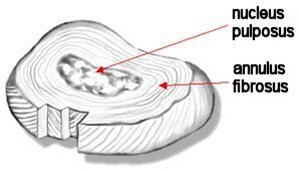Monthly Archives: April 2017
Lower Back Pain – Degenerative Disc Disease
Posted on April 7, 2017 by admin
Despite the seemingly alarming name, degenerative disc disease (DDD) is one of the most common causes for lower back pain. It is not strictly considered a disease, as most everyone has some form of disc degeneration as they age, but depending on the condition, the symptoms may flare up more often and intensely than others.
The spine is built up of segments of bone, each called vertebrae, with intervertebral discs in between, acting as a shock-absorbing ‘cushion’ to protect the vertebrae from damage. These discs are made of two structures: the nucleus pulposus, a jelly-like substance in the middle of the disc that absorbs shock, and the annulus fibrosis, the external fibres that keep the nucleus pulposus intact. A healthy disc is thick and flexible, but over time it becomes thinner as the nucleus pulposus leaks through the disc and annulus fibrosis, leading to a decreased ability to absorb shock within the backbone, causing pain. As we age, the disc also becomes more rigid and dehydrated, which creates a lesser range of movement.
Many people with DDD do live without pain, however, symptoms are fairly common and vary from patient to patient, depending on a variety of factors including fitness level, age, lifestyle, or the presence of an injury. The pain can flare up lasting for days or months before returning to baseline levels. It can be related to certain activities such as bending, twisting, and sitting down, and it can even disable a person, albeit rare. For some people, the pain may radiate from your back to your legs or shoulders.
If you are living with back pain, modifying your daily activities to better support and lessen the strain on your back can be a step toward improving your physical health. Lessen activities that require too much lifting, bending, and twisting, or learn proper ergonomics to put the least strain on the back. Exercise such as low-impact cardio (e.g. swimming), stretching programs, and exercises that strengthen your back and core can also provide a lot of support, given that they are completed properly. Avoid sitting for long periods at a time, as it puts a lot of weight on your lumbar region, and read our recent blog post on sleeping positions that help and harm your back.
For those suffering from debilitating back pain, a chiropractor can diagnose the condition, provide treatment, and offer professional advice on how to properly live and relieve these symptoms. Make an appointment with a Rupert Health Centre chiropractor today!


